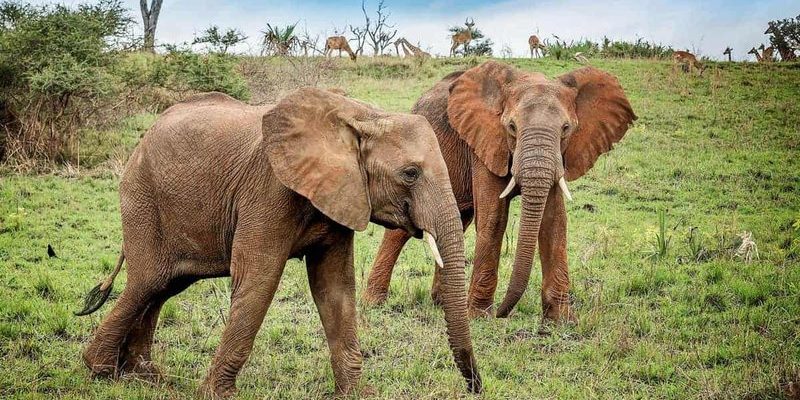
The African Bush Elephant (Loxodonta africana) isn’t just the largest land mammal; it’s an integral part of its environment. From spreading seeds to creating waterholes, these elephants contribute significantly to maintaining the biodiversity of their habitats. Let’s dive into how these magnificent creatures impact their surroundings, and why their presence is so vital to the health of the ecosystem.
Importance of African Bush Elephants in Biodiversity
One of the most significant roles of the African Bush Elephant is its contribution to biodiversity. When elephants roam the savanna, they feed on trees and shrubs, which helps maintain the right balance in plant life. You might wonder: how does munching on trees help other species? Well, by eating certain plants, elephants prevent those species from dominating the landscape. This allows a variety of plants to flourish, which in turn supports countless other creatures.
Moreover, elephants are known as keystone species. This means that their presence has a disproportionately large effect on their environment compared to their population size. For instance, when elephants knock down trees, they create open spaces that allow sunlight to reach smaller plants. This encourages growth and provides habitats for insects, birds, and other wildlife. Without elephants, the ecosystem could become less diverse, leading to a decline in many animal populations.
Seed Dispersal and Regeneration
African Bush Elephants are remarkable seed dispersers. As they munch on fruits and seeds, they often swallow them whole. When these seeds pass through their digestive system, they come out intact and ready to grow. It’s like nature’s little travel agency for seeds, helping them spread far and wide.
This process is incredibly important for the regeneration of many plant species. Imagine a young acacia tree sprouting in a new spot because an elephant took its seed on a long journey. This not only helps the individual species thrive, but it also promotes forest diversity. Different plants attract various insects and animals, creating a vibrant habitat full of life.
Creating Waterholes and Habitat Maintenance
Elephants are known for their impressive ability to dig. During dry seasons, they use their trunks and massive feet to dig wells in riverbeds, creating waterholes that become vital drinking spots for a range of animals. Picture a bustling scene where not only elephants gather, but also zebras, antelopes, and birds all coming together to quench their thirst.
These water sources play a crucial role in the ecosystem. They can become the lifeblood of the surrounding area, supporting life during times of drought. Without elephants, these natural waterholes might not exist, pushing many animals to struggle for survival. In this way, African Bush Elephants act as nature’s caretakers, ensuring that the ecosystem remains balanced and healthy.
Impact on Other Wildlife
The African Bush Elephant influences not just plants and trees but also a host of other wildlife. When they feed on certain vegetation, they create open areas that other animals can use for shelter and feeding. For example, when elephants eat thorny bushes, smaller species like dik-diks and various birds can thrive in the newly cleared spaces.
Additionally, the trails elephants create while moving through their habitat can be pathways for other animals. Whether it’s a lion stalking its prey or birds looking for food, these trails are essential for the survival of numerous species. Without the giants, many of these dynamics would be disrupted, altering the entire ecosystem.
Conservation and Challenges
Despite their importance, African Bush Elephants face significant challenges. Poaching and habitat loss due to human activities are major threats. You might be wondering why this matters. Simply put, the decline of these elephants could lead to a domino effect throughout their ecosystem.
Conservation efforts are crucial to protect these gentle giants and maintain the health of their habitats. Organizations work to combat poaching and promote sustainable land management practices. By protecting elephants, we’re not only saving a species but also preserving the intricate web of life they support.
Why Every Role Matters
When we look at the ecosystem as a complex web of life, it becomes clear that every role matters. The African Bush Elephant might be a large and powerful creature, but its role is about more than just size; it’s about contribution. They connect the dots between various species and plant life, promoting a rich and diverse environment.
So next time you see an elephant, think about all the small ways it affects the world around it. From creating waterholes to planting new trees, every action helps sustain the balance of nature. It’s a reminder that even the biggest creatures have a responsibility to their ecosystem.
In conclusion, the African Bush Elephant is much more than just a majestic figure roaming the savanna. It plays a fundamental role in maintaining biodiversity, aiding in seed dispersal, creating vital water sources, and supporting countless other wildlife. As we face modern challenges in conservation, it’s essential to remember that protecting these elephants means protecting the entire ecosystem. Let’s cherish and safeguard these incredible animals so future generations can also marvel at their beauty and the balance they maintain in the wild.

